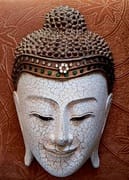Lesson 10
The Buddha taught the reality of suffering, its cause, and the path to its cessation:
- There is suffering.
- The cause of suffering is craving.
- There is a way to the end of suffering.
- The way to the end of suffering is the Noble Eightfold Path:
- Right View
- Right Intention
- Right Speech
- Right Action
- Right Livelihood
- Right Effort
- Right Mindfulness
- Right Concentration
Understanding Suffering
- Suffering must be understood.
- The source and origin of suffering must be understood.
- The cessation of suffering must be understood.
- The way leading to the cessation of suffering must be understood.
Suffering encompasses:
- Birth, old age, illness, and death.
- Sorrow, lamentation, pain, dejection, and anguish.
- Not obtaining what one desires.
- The five aggregates subject to clinging.
Craving is the source of suffering. When craving ceases, suffering also ceases. The Noble Eightfold Path leads to this liberation.
Contemplating the Cessation of Suffering
Let us continue meditating with the contemplations of wisdom. After reflecting on impermanence and fading away, focus on the cessation of suffering:
- Breathe in, focusing on cessation. Breathe out, focusing on cessation.
- Always mindful, breathe in; mindful, breathe out.
Contemplating the Removal of Taints
Progressing further in meditation, turn your focus to the removal of taints.
- The taints must be understood.
- The source and origin of taints must be understood.
- The cessation of taints must be understood.
- The way leading to the cessation of taints must be understood.
The three taints are:
- The taint of sensuality.
- The taint of existence.
- The taint of ignorance.
Ignorance is the root cause of these taints. When ignorance ceases, the taints also cease. The Noble Eightfold Path provides the means to achieve this.
Relinquishing Defilements
As you breathe, contemplate the relinquishment of defilements:
- Breathe in, focusing on relinquishment. Breathe out, focusing on relinquishment.
- Ever mindful, breathe in; mindful, breathe out.
Closing the Practice
With a pure and peaceful mind, dedicate your practice to the welfare of all sentient beings:
- May all beings be happy, be peaceful, be liberated.
When ready, gently open your eyes and emerge from meditation, carrying forward the wisdom and compassion cultivated during your practice.
♥ ♥ ♥ ♥
Please click on the following links to read previously published posts “Meditate Like The Buddha: A Step-By-Step Guide” 👉
☆ Meditate Like The Buddha #1: A Step-By-Step Guide ☆ Mr. Jagat Singh Bisht ☆
☆ Meditate Like The Buddha #2: The First Step ☆ Mr. Jagat Singh Bisht ☆
☆ Meditate Like The Buddha #3: Watch Your Breath ☆ Mr. Jagat Singh Bisht ☆
☆ Meditate Like The Buddha #4: Relax Your Body ☆ Mr. Jagat Singh Bisht ☆
☆ Meditate Like The Buddha #5: Cultivate Loving kindness ☆ Mr. Jagat Singh Bisht ☆
☆ Meditate Like The Buddha # 6: Experience your feelings ☆ Mr. Jagat Singh Bisht ☆
☆ Meditate Like The Buddha # 7: Tranquilize Mental Formations☆ Mr. Jagat Singh Bisht ☆
English Literature – Articles ☆ Meditate Like The Buddha # 8: Midway Recap ☆ Mr. Jagat Singh Bisht ☆
© Jagat Singh Bisht
Laughter Yoga Master Trainer
FounderLifeSkills
A Pathway to Authentic Happiness, Well-Being & A Fulfilling Life! We teach skills to lead a healthy, happy and meaningful life.
The Science of Happiness (Positive Psychology), Meditation, Yoga, Spirituality and Laughter Yoga. We conduct talks, seminars, workshops, retreats and training.
≈ Editor – Shri Hemant Bawankar/Editor (English) – Captain Pravin Raghuvanshi, NM















